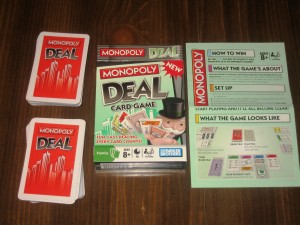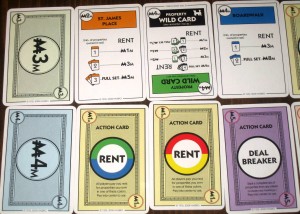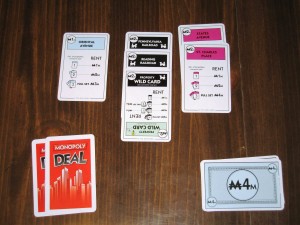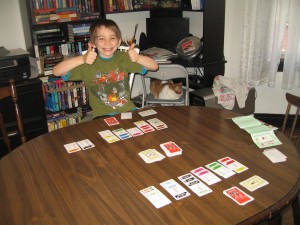Most, if not all of you, have heard of this little game called Monopoly. Okay, maybe it’s not so little. Anyway, the main complaint that I’ve heard against the original Monopoly board game is that it took too long to play, assuming that you played to be the last man (or woman) standing. Personally, I’ve always been a fan of Monopoly, mainly because it was the first board game I remember playing as a kid. I liked the idea of owning property and charging other players rent…but heck, I really hated that income tax space…I land on it EVERY SINGLE TIME. Even when I am one space away from it, the dice somehow break the laws of physics and I end up paying the two hundred bucks that I just earned for passing “Go.”
Monopoly Deal takes the one to three-hour romp that is Monopoly and compacts it into a fifteen to forty-five minute card game, depending on how many people are playing. You’d think that a lot of the original game’s rules and ideas would be lost in the transfer, but I was surprised to learn that it hadn’t. Let’s take a quick look at what comes in the box and how the game is played before heading into the review.
Components
Money Cards – These cards will prominently feature a monetary value and nothing else. These will primarily go into your bank pile.
Property Cards – These cards resemble the property cards from the original game, though they have been edited to fit the game mechanics.
Action Cards – These cards can be added to your bank pile at the value shown or played to perform an action…either one or the other, not both. Action cards that are placed into the bank pile cannot be later used as an action card.
Setup & Gameplay
Shuffle the deck, making sure that you’ve removed the quick reference cards first. Deal five to each player. The deck is placed in the center of the table and players decide who goes first.
The goal of the game is to make three complete property card sets. A set is when you have all of the properties of one color, like owning both Boardwalk and Park Place.
At the beginning of your turn, draw two cards. After that, you can play up to three cards, doing any of the following:
1) Put a money card or an action card into your bank pile.
2) Put down a property card in front of you.
3) Play an action card.
Paying Rent – Some action cards require other players to pay rent. When this happens, players must either pay with the money in their bank pile or by giving up their own property cards using the values listed on them. Since you’re trying to complete sets, you’ll want to keep money in your bank so that you don’t have to give up property cards. There’s no giving change in this game, so if all you have is a “5″ card to pay a rent of “3″, then that’s too bad, so sad.
Players continue doing the above until one person gets three complete sets, then game over.
The Review
It’s fast, I’ll give it that. My eleven year old son and I played a game and it was over before I knew what hit me. Setting up the game was easy and figuring out the rules took me less time than it normally takes for me to set up a game of Agricola…always a plus. The cards are both easy to read and easy on the eyes, making it possible to recognize what they do at a glance after playing the game a few times.
I liked the idea of a bank pile being your “defense” against your opponent taking your property cards when charging rent. The problem that I ran into was that I didn’t feel there were enough rent cards in the game to thoroughly deplete a person’s bank pile. My son and I had a sizable stash saved up about five minutes into the game and it simply became a rush to see who drew the property cards they needed to win. The rent cards we played on each other barely dented our bank piles. I have been playing around with ideas in my head to balance this: one being to remove some of the money cards from the game or to buy a second game and put all of the rent cards from the second game into the first game. I have yet to test out these ideas, if I find something that works then I’ll leave a comment below.
There is a little bit of luck involved with drawing the right cards you need, but since this game doesn’t take long to play, I can overlook it. Some games, the cards will be your best friend and other games, they’ll pull you into a bathroom stall and give you nonstop swirlies until you’re gasping for air. The sooner players accept that they won’t always win because of this mechanic, the less frustrated that they’ll be while playing.
Both Vinnie Jr and I liked playing this game and I believe it’ll be well received when I introduce it to the rest of the family. Monopoly Deal succeeds at being exactly what is sets out to be: a light, fun card game. This would make an excellent addition to family game night as well as serve as a good filler in between longer games.
Final Verdict: 6/10
—





It’s a good game. I think the game is a bit unbalanced for 1 on 1 as noted in this article. I have yet to play it with more people but I suspect the balance evens out around 4 players.
The balance DOES even out at higher amount of players. I played with 5 others, and it was just nice. Bank piles could be depleted, allowing us to make critical decisions on which properties to give up. However, luck does play quite a significant role in this game. Bad draws at the beginning will set you back and your chances of winning already diminished, even with proper planning throughout the game.